Orpheum Theater
Minneapolis
There were two Orpheum Theaters.
25 So. 7th STREET
Bryan Krefft at CinemaTreasures.org:
Minneapolis’ first Orpheum Theatre opened October 22, 1904, an elegant and luxurious Beaux-Arts building built for the Orpheum vaudeville circuit.
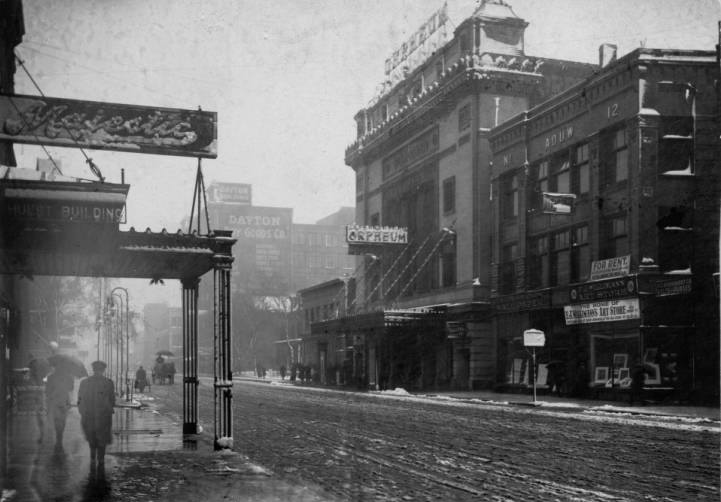
Seating around 1,490, the Orpheum Theatre’s impressive facade of limestone and terra cotta featured the circuit’s name boldly inscribed above the two-story colonnade above the main entrance, which was covered by a simple glass-and-iron canopy marquee. In the early years, the only signage on the first Orpheum Theatre was the theater’s name in large letters on the rooftop, illuminated by lightbulbs at night.
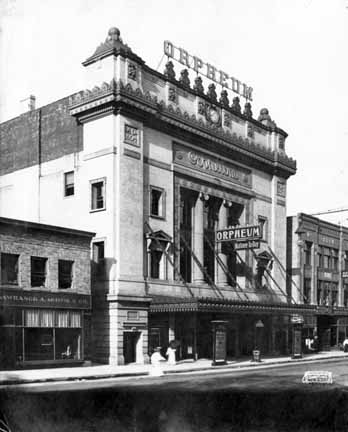
Among the many big-name performers in the Orpheum Theatre’s vaudeville days was Houdini, in his first Minneapolis appearance, in 1915.
7th STREET THEATER
When the Orpheum circuit built the much larger and more ornate Hennepin Theatre in 1921, they made that theatre their new Minneapolis home a year later, renaming it the Orpheum Theatre. The first Orpheum Theatre reopened August 27, 1922 as the 7th Street Theatre. [It appears that the program was a mix of movies and vaudeville until at least 1927.]
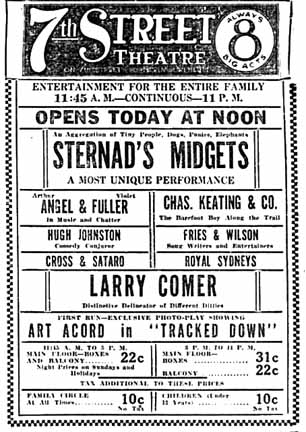
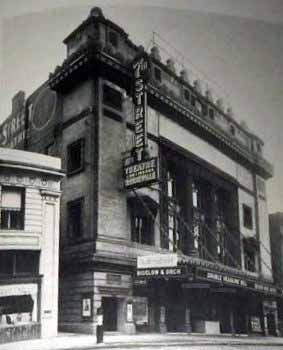
The 7th Street Theatre closed in 1940, and was torn down soon after, a sad ending for a still-beautiful and usable theater.
910 HENNEPIN AVE.
The second Orpheum Theater, which exists today, is located at 910 Hennepin Ave. It was constructed in 1921 at a cost of $1,250,000, and was originally called the New Hennepin Avenue Theater. Contemporary news accounts put the number of seats at 2,928; the current number is listed as 2,579. The theater opened on October 16, 1921.
Indented material below is from the website of the Hennepin Theater Trust, the owner of the Orpheum:
The Orpheum Theatre was designed by the Milwaukee firm of Kirchoff and Rose in a Beaux Arts style. Its first performers included the Marx Brothers, with more than 70,000 guests attending the opening week run. Billed as the largest vaudeville house in the country when opened, it became a major outlet for such entertainers as Jack Benny, George Burns and Fanny Brice. The Orpheum featured a playroom and day care off the mezzanine lobby and backstage had eight floors of dressing rooms.
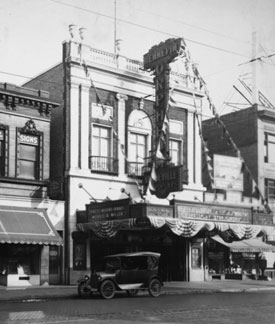
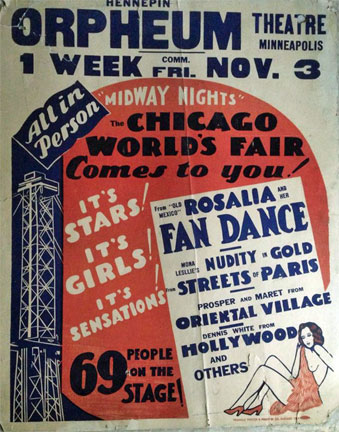
As vaudeville declined in the 1930s and ’40s, the Orpheum became one of Minneapolis’s major cinema houses, with “Gone with the Wind” in 1940 selling out every show for three weeks. It also hosted big bands including Benny Goodman, Tommy Dorsey and Count Basie.
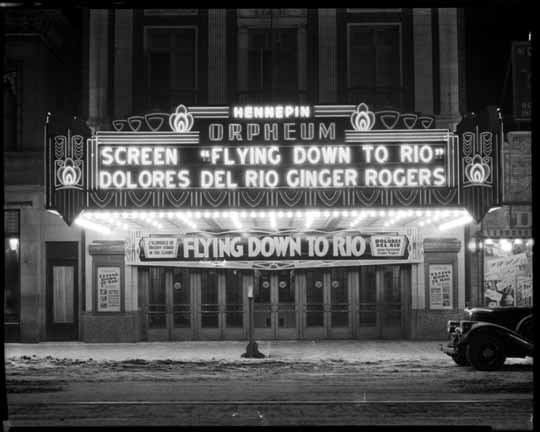
In 1959, Ted Mann, owner of six other downtown Minneapolis theatres, including the Pantages, bought the Orpheum and brought in touring productions including “My Fair Lady” and “Fiddler on the Roof.” Movies also continued to be shown, with the 1965 James Bond film “Thunderball” shattering box office records. The Orpheum set a Minneapolis record for first run engagements of Best Picture Oscar winners – nine in all – including “From Here to Eternity” in 1953 and “The Godfather” in 1972.
Bob Dylan and his brother David Zimmerman bought the theater in 1984 and Zimmerman refurbished it in “warm, living-room colors.” Broadway touring companies balked at coming to the theater because of its poor condition, lack of air-conditioning, and the deteriorating Hennepin Ave. The building is closed in 1988.
In 1988 the Minneapolis Community Development Agency purchased the Orpheum from Dylan and Zimmerman. Restoration began in 1993 and, to accommodate elaborate Broadway productions, the Orpheum stage was extended almost 20 feet, with the back wall of the theatre painstakingly removed brick by brick. Unexpected architectural discoveries made during the renovation of the lobby included six terra cotta bas relief Pompeiian friezes previously hidden under velour curtains, fake window grids and a false wall. The chandelier in the main auditorium is the theatre centerpiece. It is 15 feet high and weighs 2,000 pounds.
The theater actually consists of two separate structures: a long, fingerlike lobby that extends back from a narrow facade along Hennepin Avenue, and the auditorium, which is set back and parallels Hawthorne Avenue. The auditorium is intricately plastered, with a number of garlands, swags, medallions, and other
decorations. The ceiling has a dome with 30,000 squares of aluminum leaf. The building seats 1500 on the main floor and 1100 on the three level balcony.
Following a $10 million restoration, the Orpheum re-opened in December 1993 with a concert by Heart, and in January 1994 with the Broadway production of “Miss Saigon.” Productions that have originated at the Orpheum include “Victor/Victoria,” the pre-Broadway world premiere of Disney’s “The Lion King,” and the national tour premiere of Elton John and Tim Rice’s “AIDA.”
From its reopening in 1993 until 1996 the theater was operated by the Ordway Music Theatre, and then by the Historic Theatre Group. Historic Theatre Group’s original partner was Jujamcyn Productions. SFX (now Live Nation) bought Jujamcyn Productions in 2000. Live Nation sold most of its theatrical properties, including its Minneapolis operations, to Key Brand Entertainment in 2008. In 2005 the city transferred ownership of its theaters to the Hennepin Theatre Trust. Hennepin Theatre Trust is now the owner and operator of this magnificent structure.
Kenneth Stuart remembers the Big Band era:
The format was to show a movie and then the band would come out for a 15 minute session and then back to the movie. This went on all day and was one hell of a treat to pay a quarter to get in and be treated to all this tremendous (a 1940s term) big-band music. Big bands that appeared were Horace Heidt and his Musical Knights with the Triple-tonguing Trumpeters; Artie Shaw with “Little Jazz;” Roy Eldridge, fresh out of the Army, wearing high-water trousers; Sammy Kaye and his “So You Want To Lead A Band?” show. I led the band and did well but lost out to a pretty, hip-swinging chick, in a white summer dress, in front of a room filled with sailors from the Wold-Chamberlain Naval Station. I got to keep the autographed baton as a souvenir, however, which I promptly lost the first move I made after that. The best show I saw back then was the Gene Krupa Orchestra. The huge drape curtains would close immediately after the movie in preparation for the entrance of the orchestra. First, there was a double-paradiddle and then their theme song “Starburst” started playing as the curtain opened and the band rose from below stage level, facing backwards and then turning to present itself to the audience. Everything was in slow motion except the theme song. I’ve seen big bands all over the place including in, at least, three countries and that first showing by the Gene Krupa big band was the greatest musical thrill of my life.


